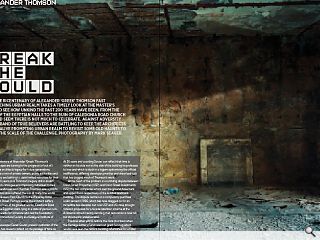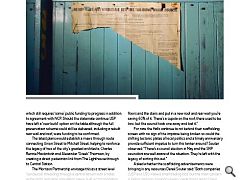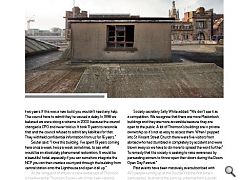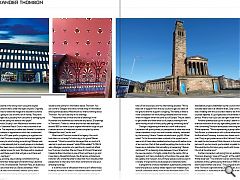Alexander Thomson: Break the Mould
21 Apr 2017
With the bicentenary of Alexander ‘Greek’ Thomson fast approaching Urban Realm takes a timely look at the master’s work to see how unkind the past 200 years have been. From the decay of the Egyptian Halls to the ruin of Caledonia Road Church it would seem there is not much to celebrate. Against adversity a small band of true believers are battling to keep the architects legacy alive prompting Urban Realm to revisit some old haunts to assess the scale of the challenge. Photography by Mark Seager.
With the bicentenary of Alexander ‘Greek’ Thomson’s birth upon us eyes are turning to the progress (or lack of) in securing the architects legacy for future generations. Custodians are a mix of private owners, public authorities and volunteers who are battling to claim limited resources for their cause but, 200 years on is Thomson’s legacy still in doubt?With a back catalogue encompassing individual homes, tenements, warehouses and churches Thomson was a prolific architect but has since suffered the loss of many fine works ranging from Queens Park Church to the Waverley Hotel on Sauchiehall Street. Perhaps worse the architect suffers the ignominy of two of his greatest works, Caledonia Road Church and the Egyptian Halls, lying in a state of parlous ruin. A scandalous waste for someone who led the foundation of Glasgow Architectural Society and Glasgow Institute of Architects.
Dundee developer Derek Souter, present custodian of the Egyptian Hall, has cause to reflect on the passage of time as he prowls the crumbling corridors of his stalled hotel vision. At 36 years and counting Souter can reflect that time is neither on his side nor on the side of the building he professes to love and which is stuck in a logjam epitomising the official indifference, differing developer priorities and sheer bad luck that has dogged much of Thomson’s work.
At the heart of the problem is a rumbling dispute between Union Street Properties (USP) and Union Street Investments (USI) the two companies which own the ground/basement and upper floors respectively of the A-listed landmark building. The dispute centres on a compulsory purchase order served in 1996, which has now dragged on for an incredible two decades but now USP and USI have brought forward proposals for a façade retention scheme at the A-listed landmark having deciding that restoration is now ‘all but structurally undeliverable’.
Previous attempts to restore the Halls stumbled when the Heritage Lottery Fund ruled out grant funding which would have seen the historic building refurbished for a hotel operator, casting doubt on the delivery of this latest scheme which still requires ‘some’ public funding to progress in addition to agreement with NCP. Should the stalemate continue USP have left a ‘new build’ option on the table although the full preservation scheme could still be delivered, including a rebuilt rear wall and roof, were funding to be confirmed.
The latest plans would establish a mews through route connecting Union Street to Mitchell Street, helping to reinforce the legacy of two of the city’s greatest architects; Charles Rennie Mackintosh and Alexander ‘Greek’ Thomson, by creating a direct pedestrian link from The Lighthouse through to Central Station.
The Morrison Partnership envisage this as a street level ‘concourse’ threading through a central atrium with a hotel, restaurants and retail populating newly built accommodation behind a retained façade to a ‘modernised’ NCP car park, although a question mark hangs over whether NCP would be prepared to sacrifice their cash cow. Should they do so (and discussions have not yet begun) then there is potential to open up a strategic chunk of city centre real estate, breathing new life into the dank Union Place in the process.
Derek Souter said: “The Halls are joined onto the NCP, it’s back to back. The rear wall needs replaced and the roof needs replaced but we can save the building. The challenge is to save the floors, can we do a form of façade retention because the rear wall needs replaced anyway? If you retained the façade the floors and the stairs and put in a new roof and rear wall you’re saving 60% of it. There’s a cupola on the roof, there used to be two, but the council took one away and lost it.”
For now the Halls continue to rot behind their scaffolding screen with no sign of the impasse being broken so could the shifting tectonic plates of local politics and a timely anniversary provide sufficient impetus to turn this tanker around? Souter observed: “There’s a council election in May and the SNP councilors are well aware of the situation. They’re left with the legacy of sorting this out.”
Asked whether the scaffolding advertisements were bringing in any resources Derek Souter said: ‘Both companies (USP and USI) make a small trading loss’ but the main concern is falling masonry bonking unwary pedestrians along Union Street, prompting the removal of parapet coping stones, hopefully to be reintroduced at some indeterminate future. As Souter attests: “The scaffolding has been up for seven years and it could be up for another seven without a solution. We can’t take the scaffolding down because of structural issues, which the council now reluctantly accept.”
“The council have no stake in the building. This building has an £18m deficit, no-one’s going to spend £18m to get £6m back. It’s been non-viable since 1996 and all that’s happened is it’s got worse. It needed £2m in 1998 and it needs around £16m now. I don’t know, the figures haven’t been updated for two years. If this was a new build you wouldn’t need any help. The council have to admit they’ve caused a delay. In 1998 we believed we were doing a scheme in 2000 because the council changed a CPO and never told us. It took 11 years to reconcile that and the council refused to admit any liabilities for that. They withheld confidential information from us for 16 years.”
Souter said: “I love this building. I’ve spent 19 years coming here once a week, twice a week sometimes, to see what would be an absolutely phenomenal restoration. It would be a beautiful hotel, especially if you can somehow integrate the NCP you can then create a courtyard through the building from central station onto the Lighthouse and open it all up.”
At the vanguard of efforts to raise awareness of Thomson is the Alexander Thomson Society which has been valiantly championing their man, successfully overturning historic indifference and battling to preserve what remains of his built legacy. One handicap members face is being visible within the all-enveloping shadow cast by Mackintosh but with the bicentenary of the architects birth this year a chink of opportunity now presents itself. Asked whether the Thomson Society was in effect competing for scant resources or if their aims were complementary chairman Mark Baines said: “We probably are competing but unknowingly. There are other projects, such as the Citizens Theatre, which are being funded by the city council from the City Fund.”
Society secretary Sally White added: “We don’t see it as a competition. We recognise that there are more Mackintosh buildings and they are more accessible because they are open to the public. A lot of Thomson’s buildings are in private ownership so it’s not as easy to access them. When I popped into St Vincent Street Church there were five visitors from abroad who had stumbled in completely by accident and were blown away so we have to do more to spread the word further.” To remedy that the society is seeking to raise awareness by persuading owners to throw open their doors during the Doors Open Day Festival.”
Past events have been massively oversubscribed with 450 people turning up at the Double Villa the first time it participated, illustrating the pent-up potential from a public clamoring for more than just St Vincent Street Church, which opens at lunch times, or Holmwood House which is open part of the year, part of the week. Baines said: “They have a very small exhibition space and its exhibition wasn’t about Thomson last year, it was about Cottiers Furniture. That’s why you really need something to show people what we have and encourage people to come.”
Encouragement for many will come in the form of newly re-instated stencil work, something the society is particularly excited to see taking shape. White said: “There are specialist painters at Holmwood just now who are recreating the decorative scheme in the dining room using the original stencils, they know what’s under the layers of paint. Originally the decision was to reveal the image and decorative scheme but that was going to cost an awful lot of money. They have recently changed tack, possibly from concerns of damaging the paintwork and are doing the stencils onto paper.”
The Thomson Society’s own Mackintosh moment came in 1965 when Caledonia Roach Church was consumed in an conflagration. The response (or rather lack thereof) is indicative of a wider imbalance in appreciation which has condemned the landmark to a 50-year spell in purgatory as a gutted ruin. Is it the case that Thomson simply lacks the local and global appeal necessary to untie funding purse strings? Baines said: “He is known internationally but by small groups or individuals who have either been here or stumbled upon him. He is known but could be better known for sure. We hope with a couple of publications and these events that will get us out there and gather more members.”
This long, grinding, slog is taking a small band of true believers toward their stated goal of transforming Caledonia Road Church into One Alexander Thomson Place, an audacious intervention set amidst the ruin. Baines remarked: “We’ll promote it culturally and artistically without going down a commercial route and making earrings and bracelets. It would be the centre for information about Thomson. You can come to Glasgow and have a whole array of information and experiences about Mackintosh but there’s nothing about Thomson. You can’t see any of his drawings.
“Mackintosh has a whole archive of drawings in the Hunterian and elsewhere but there are only about 28 drawings of Thomson’s. There is a whole archive that was destroyed around 1880 so there is scant original information to go on just a certain amount of measured studies compiled by others. Gillespie Kidd and Coia for one.”
What would Thomson make of his legacy if he could look down on us today? Is he turning in his grave? Baines answered: “I think he would be dismayed that so much of it was lost in post-war renewal,” while White added: “In 1964 it was a Glasgow councilor who said the city could not afford two Thomson churches. We can’t have St Vincent Street and Caledonia Road churches so one of them will have to go and it was Henry-Russell Hitchcock, the American architectural historian who wrote the letter to stop that. How ridiculous that people have to intervene from other continents to save your amazing buildings.”
Is it still the view of officialdom that we can’t afford these buildings and that we need to consolidate within one or two? Not in the eyes of White who has seen a marked change of tone (if not resources) over the intervening decades: “We’ve had a lot of support from the city council to get our ideas off the ground and the support is ongoing. The reality is there is more competition for the funding available and who knows what will happen when we come out of Europe. The pot seems to get smaller and there are a lot of projects looking for the same money and all of them justify getting something done.”
Change is happening however as a swift walk around Laurieston will quickly attest, as perceptions of what was once urban wasteland morph into well-ordered urbanity, cemented by the looming Citizens Theatre refurbishment (pg 88). White noted: “In the time we’ve been involved in the project we’ve seen a lot of these ideas realized and we hope we’ll realise some of our own too. Part of that would be getting the clocks on the towers as an indication that something is happening.” Baines continued: “It’s a stepping stone between Crown Street and the new Laurieston. It’s highly visible from the centre. We’ve designed it so it has a multiplicity of functions; the usual café/bar, gallery and museum. Any of these spaces could be used in a variety of ways both by local people and national events.”
A programme of stone indentation is planned to protect the tower and previous surface render repairs now threatening to spall off, potentially taking some of the stonework with it. The tower remains structurally stable however thanks to a £200k stabilization project undertaken by the council which saw concrete slabs tied in at different levels. Sally continued: “We had a meeting with the council last week to ask if the lighting could be repaired. It’s just lightbulbs concentrated on the portico. What’s nice is you can see right inside when its lit up.
Another potential ace up the society’s sleeve is a long overdue extension of the city sightseeing buses south of the river, something Thomson enthusiasts have long advocated: White explained: “We’re representing a group called South Side Routes, a collaboration with cultural attractions such as the Burrell and Tramway, to entice tour buses south of the river. They’ve got posters around the Cathcart Circle but you do need the bus because Pollok House is in the middle of the park and if you’re a tourist you’re reliant on public transport. We would be the first stop going south with Govan Old Parish Church at the other end.”
Further momentum will spring from an exhibition of Thomson drawings, ‘Lines of Thought’, at The Lighthouse. White observed: “The Unknown Genius was the inaugural exhibition at the Lighthouse but that was in 1999 and there hasn’t been another one since.” This just goes to show that while Thomson’s light still shines 200 years on, it is dimming, necessitating a redoubling of effort if there is to be something to celebrate in future.
|
|
Read next: Housing Crisis: Home Front
Read previous: Urban Realm TOP100 Architects 2017
Back to April 2017
Browse Features Archive
Search
News
For more news from the industry visit our News section.
Features & Reports
For more information from the industry visit our Features & Reports section.






